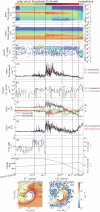Mars's induced magnetosphere can degenerate
- PMID: 39294383
- PMCID: PMC11446820
- DOI: 10.1038/s41586-024-07959-z
Mars's induced magnetosphere can degenerate
Abstract
The interaction between planets and stellar winds can lead to atmospheric loss and is, thus, important for the evolution of planetary atmospheres1. The planets in our Solar System typically interact with the solar wind, whose velocity is at a large angle to the embedded stellar magnetic field. For planets without an intrinsic magnetic field, this interaction creates an induced magnetosphere and a bow shock in front of the planet2. However, when the angle between the solar wind velocity and the solar wind magnetic field (cone angle) is small, the interaction is very different3. Here we show that when the cone angle is small at Mars, the induced magnetosphere degenerates. There is no shock on the dayside, only weak flank shocks. A cross-flow plume appears and the ambipolar field drives planetary ions upstream. Hybrid simulations with a 4° cone angle show agreement with observations by the Mars Atmosphere and Volatile Evolution mission4 and Mars Express5. Degenerate, induced magnetospheres are complex and not yet explored objects. It remains to be studied what the secondary effects are on processes like atmospheric loss through ion escape.
© 2024. The Author(s).
Conflict of interest statement
The authors declare no competing interests.
Figures






References
-
- Ramstad, R. & Barabash, S. Do intrinsic magnetic fields protect planetary atmospheres from stellar winds? Space Sci. Rev.217, 36 (2021).
-
- Slavin, J. A. & Holzer, R. E. Solar wind flow about the terrestrial planets. I. Modeling bow shock position and shape. J. Geophys. Res.: Space Phys.86, 11401–11418 (1981).
-
- Dubinin, E. et al. Toroidal and poloidal magnetic fields at Venus. Venus Express observations. Planet. Space Sci.87, 19–29 (2013).
-
- Jakosky, B. M. et al. Loss of the Martian atmosphere to space: present day loss rates determined from MAVEN observations and integrated loss through time. Icarus315, 146–157 (2018).
-
- Barabash, S. et al. The analyzer of space plasmas and energetic atoms (ASPERA-3) for the Mars Express mission. Space Sci. Rev.126, 113–164 (2006).
LinkOut - more resources
Full Text Sources
Miscellaneous

